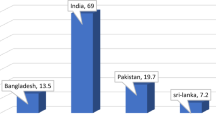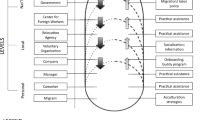Abstract
Critics of affirmative action policies often claim that increasing the representation of members of marginalized communities in jobs comes at the cost of reduced productive efficiency. This paper reports on a systematic empirical analysis of productivity in the Indian Railways - the world’s largest employer subject to affirmative action - in which we examined whether or not higher proportions of affirmative action beneficiaries in employment reduce efficiency in the railway system. We found no evidence for such an effect; and some of our results provide tentative support for the claim that greater labor force diversity boosts productivity.
Similar content being viewed by others
Notes
There are additional quotas for “Other Backward Classes” (OBCs) – i.e., castes and communities low in the socioeconomic hierarchy but above SCs and STs. We focused on the latter because that the AA policy for them has been stable over the time period of our study. See Deshpande (2011) and Weisskopf (2004) for details of India’s AA policies, as well as discussion of the debates in India surrounding these policies.
For a thorough explication of the DEA approach, see Ray (2004).
For more details on how we have responded to the concerns of critics, see Deshpande and Weisskopf (2014), section 5.
This recalls the arguments in favor of AA in U.S. educational institutions made to the Supreme Court by U.S. military officers, who want to avoid having just white men in charge of troops that are disproportionately of color
Page (2007) has shown convincingly how groups that display a wide range of perspectives outperform groups of like-minded experts.
References
Deshpande A. Grammar of caste: economic discrimination in contemporary India. New Delhi: Oxford University Press; 2011.
Deshpande A, Newman K. Where the path leads: the role of caste in post university employment expectations. Econ Polit Wkly. 2007;42:4133–40.
Deshpande A, Weisskopf TE. Does affirmative action reduce productivity? A case study of the Indian railways. World Dev. 2014: 169–180.
Holzer HJ, Neumark D. Assessing affirmative action. J Econ Lit. 2000;38:483–568.
Levinsohn J, Petrin A. Estimating production functions using inputs to control for unobservables. Rev Econ Stud. 2003;70:317–41.
Page S. The difference: how the power of diversity creates better groups, firms, schools, and societies. Princeton: Princeton University Press; 2007.
Ray SC. Data envelopment analysis: theory and techniques for economics and operations research. Cambridge: Cambridge University Press; 2004.
Weisskopf TE. Affirmative action in the United States and India: a comparative perspective. London: Routledge; 2004.
Author information
Authors and Affiliations
Corresponding author
Additional information
This is an abridged and modified version of Deshpande. & Weisskopf, “Does Affirmative Action Reduce Productivity? A Case Study of the Indian Railways,” published in World Development (December 2014): pp. 169–180. It is included in this volume because it was one of the papers presented at the conference on “Subaltern Peoples” organized by the Global Inequality Research Initiative and held at Duke University on April 3–5, 2014.
About this article
Cite this article
Deshpande, A., Weisskopf, T.E. Affirmative Action and Productivity in the Indian Railways. Rev Black Polit Econ 43, 245–251 (2016). https://doi.org/10.1007/s12114-015-9217-2
Published:
Issue Date:
DOI: https://doi.org/10.1007/s12114-015-9217-2




